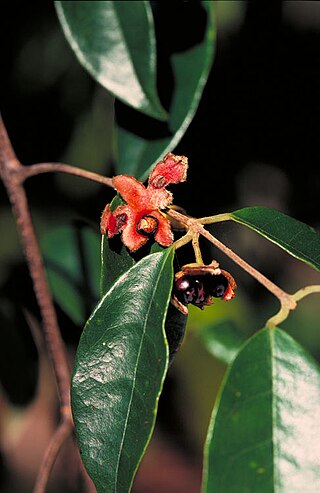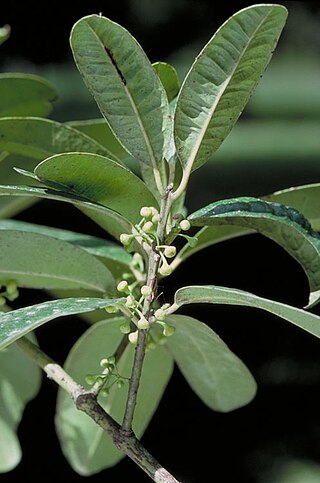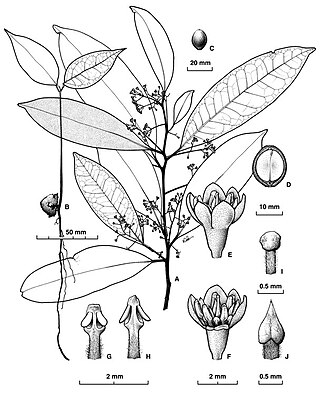
Cryptocarya is a genus of about 360 species of flowering plants in the laurel family, Lauraceae. Most species are trees, occasionally shrubs, distributed through the Neotropical, Afrotropical, Indomalayan, and Australasian realms. Most plants in the genus Cryptocarya have leaves arranged alternately along the stems, small flowers with 6 tepals, stamens in 2 rows, the inner row alternating with staminodes, and the fruit is a drupe.

Hedycarya angustifolia, commonly known as native mulberry, Australian mulberry, or djelwuck is a species of flowering plant in the family Monimiaceae, and is endemic to eastern Australia. It is a shrub or small tree with elliptic or egg-shaped to lance-shaped leaves and male and female flowers on separate plants. Male flowers are borne in branched clusters of 5 to 16 and have 8 tepals and about 50 stamens and female flowers have about 12 tepals and 40 to 50 carpels. The fruit is a more or less spherical, tightly clustered yellow or orange drupes.

Trochocarpa montana, commonly known as mountain tree-heath, is a species of flowering plant in the family Ericaceae and is endemic to high altitude places in New South Wales. It is a much-branched shrub with narrowly egg-shaped, narrowly elliptical to broadly egg-shaped leaves, racemes of creamy-brown, tube-shaped flowers, and purple to black drupes.

Cryptocarya bidwillii, commonly known as yellow laurel, is a species of flowering plant in the laurel family and is endemic to eastern Australia. Its leaves are lance-shaped to elliptic, the flowers creamy-white and tube-shaped, and the fruit an elliptic black drupe.

Acrotriche divaricata is a species of flowering plant in the family Ericaceae and is endemic to New South Wales. It is a bushy shrub with sharply-pointed lance-shaped leaves and spikes of 3 to 5 green or cream-coloured flowers and spherical, red drupes.

Palmeria scandens, commonly known as anchor vine or pomegranate vine, is a species of flowering plant in the family Monimiaceae and is native to Queensland, New South Wales and New Guinea. It is a woody vine with elliptic to oblong leaves and male and female flowers borne on separate plants, male flowers usually with thirty to forty stamens and female flowers with about ten carpels. The fruit is green, splitting to form a pinkish receptacle with 3 to 7 black or red drupes.

Cryptocarya corrugata, commonly known as corduroy laurel, oak walnut, acidwood or bull's breath, is a species of flowering plant in the laurel family and is endemic to north Queensland. It is a tree with egg-shaped to elliptic leaves, the flowers creamy-green, slightly perfumed and tube-shaped, and the fruit a spherical black to bluish-black drupe.

Cryptocarya cunninghamii, commonly known as Cunningham's laurel or coconut laurel, is a species of flowering plant in the laurel family and is endemic to northern Australia. It is a tree with oblong to elliptic leaves, the flowers creamy-green and tube-shaped, and the fruit a spherical black to purplish-blackdrupe.

Palmeria hypotephra is a species of flowering plant in the family Monimiaceae and is endemic to Queensland. It is a woody climber with elliptic to egg-shaped leaves, male and female flowers on separate plants with 4 or 5 tepals, male flowers with 30 to 35 stamens, female flowers with 10 to 12 carpels, and spherical, dark brown to black drupes.

Wilkiea rigidifolia is a species of flowering plant in the family Monimiaceae, and is native to north Queensland and New Guinea. It is a shrub or small tree with elliptic to broadly elliptic or oblong leaves and male and female flowers on separate plants. Male flowers are borne in clusters of 20 to 30 and have 4 pairs of tepals and 2 or 3 pairs of stamens and female flowers have 2 pairs of tepals and 40 to 50 carpels. The fruit is a glossy black drupe.
Wilkiea smithii is a species of flowering plant in the family Monimiaceae, and is endemic to north-eastern Queensland. It is a shrub or small, slender tree with elliptic or oblong leaves and male and female flowers on separate plants. Male flowers are borne in clusters of about 5 and have 8 tepals and 2 pairs of stamens and female flowers have 20 to 40 carpels. The fruit is a glaucous, purplish to black drupe.

Cryptocarya angulata, commonly known as ivory laurel, ivory walnut, bull's breath or acidwood, is a tree in the laurel family and is endemic to north Queensland, Australia. Its leaves are lance-shaped to elliptic or egg-shaped, the flowers tube-shaped and creamy-green and the fruit a bluish or black drupe.

Cryptocarya bamagana, commonly known as Bamaga walnut, is a tree in the laurel family and is endemic to Cape York Peninsula. Its leaves are lance-shaped to elliptic or egg-shaped, the flowers cream-coloured and tube-shaped, and the fruit a spherical black drupe.

Cryptocarya bellendenkerana is a tree in the laurel family and is endemic to North Queensland. Its leaves are lance-shaped to egg-shaped, the flowers creamy-green and tube-shaped, and the fruit a spherical black drupe.

Cryptocarya brassii is a species of flowering plant in the laurel family and is native to far north Queensland and Papua New Guinea. Its leaves are elliptic to oblong or lance-shaped, the flowers cream-coloured and tube-shaped, and the fruit an elliptic black to bluish-black drupe.

Cryptocarya burckiana is a tree in the laurel family and is native to Cape York Peninsula in Queensland and to Malesia. Its leaves are lance-shaped to elliptic, the flowers cream-coloured and tube-shaped, and the fruit a spherical black drupe.
Cryptocarya cercophylla is a species of flowering plant in the laurel family and is endemism to Wooroonooran National Park in north Queensland. It is a poorly-formed tree with egg-shaped to elliptic leaves, the flowers creamy-green or cream-coloured and tube-shaped, and the fruit an elliptic, red to shiny black drupe.

Cryptocarya clarksoniana, commonly known as Clarkson's laurel, is a tree in the laurel family and is endemic to north Queensland. Its leaves are lance-shaped to elliptic, the flowers creamy-green and tube-shaped, and the fruit a spherical black drupe.

Cryptocarya claudiana, commonly known as Claudie laurel, is a tree in the laurel family and is endemic to Cape York Peninsula in Queensland. Its leaves are oblong to elliptic, the flowers creamy-green, perfumed and tube-shaped, and the fruit an elliptic or spherical black drupe.

Cryptocarya densiflora, commonly known as cinnamon laurel or white laurel, is a tree in the laurel family and is native to north Queensland and parts of Indonesia. Its leaves are lance-shaped to elliptic, the flowers yellowish-green and brown, tube-shaped but not perfumed, and the fruit is a flattened spherical, reddish maroon drupe that turns black when ripe.


















